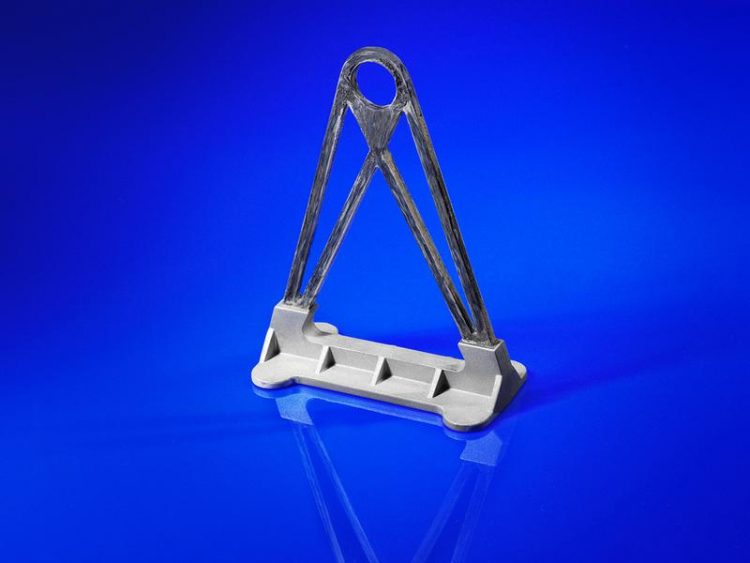Without Contact Corrosion: Joining Hybrid Components of CFRP and Aluminum

Holding bracket for aircraft manufacture produced using the hybrid casting technology. © Fraunhofer IFAM
The combination of fibre composite materials and lightweight materials presents unique challenges to all established joining technologies. In addition to the need for high connection strengths to be maintained, the joining itself should not add any significant weight. Contact corrosion must also be prevented for both materials.
In addition to adhesively bonded or riveted hybrid connections, the hybrid high-pressure die casting presented here offers a new approach to save weight while simultaneously permanently preventing the problematic issue of contact corrosion.
Achieving a hybrid component with just a few process steps
Within the newly developed process, prior to the casting the CFRP structures are partially coated with a highly temperature stable plastic (PEEK), which does not begin to significantly decompose until temperatures of around 550 °C have been reached. In a subsequent casting process step, the CFRP components are placed into the high-pressure casting die and are cast in the area of the plastic with aluminum at a temperature of around 700 °C.
Through a targeted and controlled high-pressure die casting process with short cycle times as well as the selection of suitable process and material parameters, an integration of the plastic into the high-pressure casting process is possible, despite the temperature differences, without the properties of the plastic being affected.
Thus, a stable connection is created between the two materials during the initial manufacture of the aluminum component by casting. Thus, time-consuming processing steps or pre-treatment of the joining surfaces are not necessary. Undercuts can optionally be made in the joining zone in order to further increase the strength. Connective strengths of 20 MPa achieved with this process are already comparable with those of structural adhesives.
Development for series production
In many sectors such as the automobile industry, aerospace, wind energy and sports equipment as well as in conventional machine construction, the demand for hybrid materials is high. For the production of high quantities, there is a need for efficient series manufacture.
In order to meet these demands, a bracket from the aircraft manufacturing that is installed in large quantities was chosen for the feasibility study. The goal of the development team is now the further development of the hybrid casting technology based on this component so that a process window can be demonstrated for the aluminum high-pressure casting in order to be able to reproducibly manufacture hybrid connections between CFRP and aluminum in series production.
For the research activities in the field of hybrid casting, Fraunhofer IFAM has two high pressure casting facilities (Bühler, type SC N/66 with 660t closing force; Frech, DAK250 with 290t closing force) as well as peripheral equipment on an industrial series production scale. With these facilities, Fraunhofer IFAM is the largest extramural research institute in the field of casting technology in Germany.
Project partners
Fraunhofer Institute for Manufacturing Technology and Advanced Materials IFAM
Faserinstitut Bremen e.V.
Funding
Funding code: funded by the DFG (BU 1796/11)
Armin Schmid M.Sc.
Fraunhofer-Institut für Fertigungstechnik und Angewandte Materialforschung IFAM
Phone +49 421 2246-7151 | Wiener Straße 12 | 28359 Bremen | www.ifam.fraunhofer.de | armin.schmid@ifam.fraunhofer.de
Media Contact
All latest news from the category: Materials Sciences
Materials management deals with the research, development, manufacturing and processing of raw and industrial materials. Key aspects here are biological and medical issues, which play an increasingly important role in this field.
innovations-report offers in-depth articles related to the development and application of materials and the structure and properties of new materials.
Newest articles

Superradiant atoms could push the boundaries of how precisely time can be measured
Superradiant atoms can help us measure time more precisely than ever. In a new study, researchers from the University of Copenhagen present a new method for measuring the time interval,…

Ion thermoelectric conversion devices for near room temperature
The electrode sheet of the thermoelectric device consists of ionic hydrogel, which is sandwiched between the electrodes to form, and the Prussian blue on the electrode undergoes a redox reaction…

Zap Energy achieves 37-million-degree temperatures in a compact device
New publication reports record electron temperatures for a small-scale, sheared-flow-stabilized Z-pinch fusion device. In the nine decades since humans first produced fusion reactions, only a few fusion technologies have demonstrated…





















